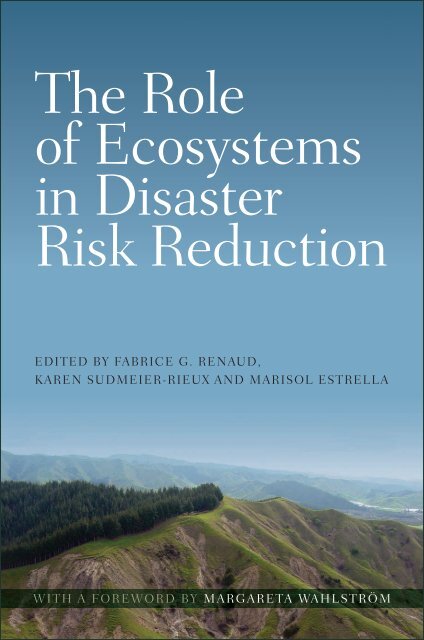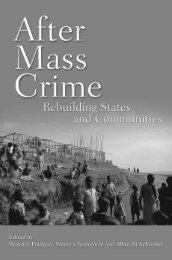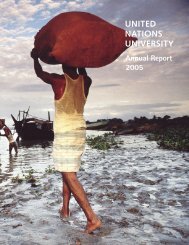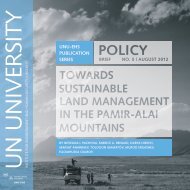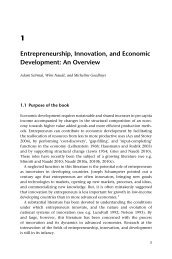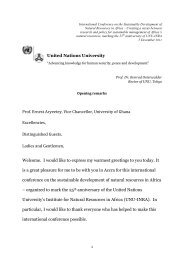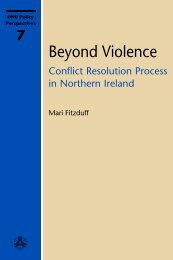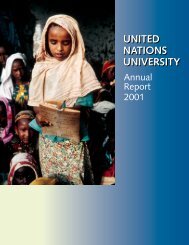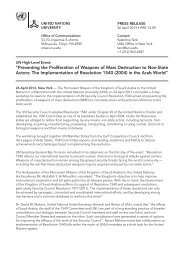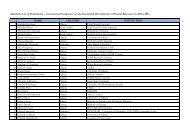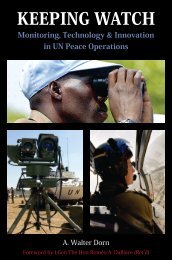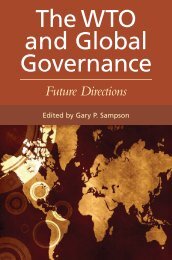Sample Chapter - United Nations University
Sample Chapter - United Nations University
Sample Chapter - United Nations University
You also want an ePaper? Increase the reach of your titles
YUMPU automatically turns print PDFs into web optimized ePapers that Google loves.
The Role<br />
of Ecosystems<br />
in Disaster<br />
Risk Reduction<br />
EDITED BY FABRICE G. RENAUD,<br />
KAREN SUDMEIER-RIEUX AND MARISOL ESTRELLA<br />
WITH A FOREWORD BY MARGARETA WAHLSTRÖM
The role of ecosystems in disaster<br />
risk reduction<br />
Edited by Fabrice G. Renaud, Karen Sudmeier-Rieux<br />
and Marisol Estrella
Contents<br />
List of figures . . . . . . . . . . . . . . . . . . . . . . . . . . . . . . . . . . . . . . . . . . . . . .<br />
List of tables . . . . . . . . . . . . . . . . . . . . . . . . . . . . . . . . . . . . . . . . . . . . . .<br />
List of boxes . . . . . . . . . . . . . . . . . . . . . . . . . . . . . . . . . . . . . . . . . . . . . .<br />
List of contributors . . . . . . . . . . . . . . . . . . . . . . . . . . . . . . . . . . . . . . . . .<br />
xii<br />
xvii<br />
xix<br />
xxi<br />
Foreword by Margareta Wahlström .. . . . . . . . . . . . . . . . . . . . . . . . . . xxviii<br />
Acknowledgements . . . . . . . . . . . . . . . . . . . . . . . . . . . . . . . . . . . . . . . .<br />
xxx<br />
List of abbreviations . . . . . . . . . . . . . . . . . . . . . . . . . . . . . . . . . . . . . . . . xxxii<br />
Part I: Why do ecosystems matter in disaster risk reduction? . . . . . 1<br />
1 The relevance of ecosystems for disaster risk reduction . . . . . . . 3<br />
Fabrice G. Renaud, Karen Sudmeier-Rieux and Marisol<br />
Estrella<br />
2 Ecosystem-based disaster risk reduction (Eco-DRR):<br />
An overview . . . . . . . . . . . . . . . . . . . . . . . . . . . . . . . . . . . . . . . . . . . 26<br />
Marisol Estrella and Nina Saalismaa
x<br />
Contents<br />
Part II: Ecosystems and coastal disaster risk reduction . . . . . . . . . . 55<br />
3 Investigating the performance of coastal ecosystems for<br />
hazard mitigation . . . . . . . . . . . . . . . . . . . . . . . . . . . . . . . . . . . . . . . 57<br />
Sam S.L. Hettiarachchi, Saman P. Samarawickrama,<br />
Harindra J.S. Fernando, A. Harsha R. Ratnasooriya, N.A.<br />
Kithsiri Nandasena and Srimal Bandara<br />
4 Bioshields: Mangrove ecosystems as resilient natural coastal<br />
defences . . . . . . . . . . . . . . . . . . . . . . . . . . . . . . . . . . . . . . . . . . . . . . . 82<br />
Carmen Lacambra, Daniel A. Friess, Tom Spencer and Iris<br />
Möller<br />
5 Integrating the role of ecosystems in disaster risk and<br />
vulnerability assessments: Lessons from the Risk and<br />
Vulnerability Assessment Methodology Development<br />
Project (RiVAMP) in Negril, Jamaica . . . . . . . . . . . . . . . . . . . . . . 109<br />
Pascal Peduzzi, Adonis Velegrakis, Marisol Estrella and<br />
Bruno Chatenoux<br />
6 Increasing the resilience of human and natural communities<br />
to coastal hazards: Supporting decisions in New York and<br />
Connecticut . . . . . . . . . . . . . . . . . . . . . . . . . . . . . . . . . . . . . . . . . . . . 140<br />
Michael W. Beck, Ben Gilmer, Zach Ferdaña, George T.<br />
Raber, Christine C. Shepard, Imen Meliane, Jeffrey D. Stone,<br />
Adam W. Whelchel, Mark Hoover and Sarah Newkirk<br />
7 A coastal adaptation strategy for the City of Cape Town:<br />
An ecosystem-based management approach towards<br />
risk reduction . . . . . . . . . . . . . . . . . . . . . . . . . . . . . . . . . . . . . . . . . . 164<br />
Darryl Colenbrander, Penny Price, Gregg Oelofse and<br />
Sakhile Tsotsobe<br />
8 Lessons from local initiatives on ecosystem-based climate<br />
change work in Tonga . . . . . . . . . . . . . . . . . . . . . . . . . . . . . . . . . . . 191<br />
Stavros Mavrogenis and Ilan Kelman<br />
Part III: Water resources management for disaster risk reduction. 219<br />
9 Good flood, bad flood: Maintaining dynamic river basins for<br />
community resilience . . . . . . . . . . . . . . . . . . . . . . . . . . . . . . . . . . . . 221<br />
Pieter van Eijk, Chris Baker, Romana Gaspirc and Ritesh<br />
Kumar
CONTENTS<br />
xi<br />
10 Utilizing integrated water resources management approaches<br />
to support disaster risk reduction . . . . . . . . . . . . . . . . . . . . . . . . . . 248<br />
James Dalton, Radhika Murti and Alvin Chandra<br />
11 The matter is not if, but when and where: The role of capacity<br />
development in disaster risk reduction aiming for a sustainable<br />
water supply and sanitation . . . . . . . . . . . . . . . . . . . . . . . . . . . . . . . 270<br />
Madeleine Fogde, Luis Macario and Kirsten Carey<br />
Part IV: Sustainable land management for disaster risk reduction. 291<br />
12 The role of vegetation cover change in landslide hazard<br />
and risk . . . . . . . . . . . . . . . . . . . . . . . . . . . . . . . . . . . . . . . . . . . . . . . . 293<br />
Maria Papathoma-Koehle and Thomas Glade<br />
13 Protection forests: A key factor in integrated risk management<br />
in the Alps . . . . . . . . . . . . . . . . . . . . . . . . . . . . . . . . . . . . . . . . . . . . . 321<br />
André Wehrli and Luuk Dorren<br />
14 Forest cover and landslide trends: A case study from Dolakha<br />
District in central-eastern Nepal, 1992–2009 . . . . . . . . . . . . . . . . . 343<br />
Stéphanie Jaquet, Karen Sudmeier-Rieux, Marc-Henri Derron<br />
and Michel Jaboyedoff<br />
Part V: Policy, planning and future perspectives . . . . . . . . . . . . . . . . 369<br />
15 Reducing vulnerability: The role of protected areas in<br />
mitigating natural disasters . . . . . . . . . . . . . . . . . . . . . . . . . . . . . . . 371<br />
Nigel Dudley, Kathy MacKinnon and Sue Stolton<br />
16 Urban disaster risk reduction and ecosystem services . . . . . . . . . 389<br />
Lorenzo Guadagno, Yaella Depietri and Urbano Fra Paleo<br />
17 Applying environmental impact assessments and strategic<br />
environmental assessments in disaster management . . . . . . . . . . 416<br />
Anil Kumar Gupta and Sreeja S. Nair<br />
18 Opportunities, challenges and future perspectives for<br />
ecosystem-based disaster risk reduction . . . . . . . . . . . . . . . . . . . . 437<br />
Marisol Estrella, Fabrice G. Renaud and Karen Sudmeier-<br />
Rieux<br />
Index .. . . . . . . . . . . . . . . . . . . . . . . . . . . . . . . . . . . . . . . . . . . . . . . . . . . 457
3<br />
1<br />
The relevance of ecosystems for<br />
disaster risk reduction<br />
Fabrice G. Renaud, Karen Sudmeier-Rieux and<br />
Marisol Estrella<br />
Introduction<br />
Each year we witness strikingly similar images of loss and destruction<br />
caused by disasters. 1 Disasters linked to recurring and extreme hazard<br />
events – namely floods, droughts, heat waves, tropical cyclones, volcanic<br />
eruptions and earthquakes – repeatedly undermine local and national development<br />
efforts to support livelihoods, promote economic growth and<br />
achieve overall human well-being. A closer look at disasters reveals that<br />
they are induced by a complex mix of drivers, such as people living in dangerous<br />
places, poor governance, environmental degradation, inadequate<br />
early warning, and lack of preparedness by the public and the authorities,<br />
all interlinked with challenges of development. Given the current global<br />
economic downturn and shrinking financial resources, the importance of<br />
pursuing integrated, “win–win” solutions to disaster reduction and sustainable<br />
development is more critical than ever. Ecosystem management,<br />
or the sound management of natural resources, is a well-tested solution<br />
to sustainable development that is being revisited because of its inherent<br />
“win–win” and “no-regrets” appeal to address rising disaster and climate<br />
change issues (IPCC, 2012; UNISDR, 2009a, 2011a).<br />
Worldwide, disasters are increasingly affecting people and communities,<br />
although the number of disasters, of people affected and of casualties<br />
and the extent of economic losses can vary considerably from year to<br />
year. For example, in 2010, 373 disaster events 2 were recorded (compared<br />
with 387 events on average for the period 2000–2009), resulting in about<br />
The role of ecosystems in disaster risk reduction, Renaud, Sudmeier-Rieux and Estrella (eds),<br />
<strong>United</strong> <strong>Nations</strong> <strong>University</strong> Press, 2013, ISBN 978-92-808-1221-3
4 RENAUD, SUDMEIER-RIEUX AND ESTRELLA<br />
300,000 casualties (about 80,000 on average for 2000–2009), 207 million<br />
people affected 3 (227 million on average for 2000–2009) and US$109 billion<br />
in damages (US$99 billion average for 2000–2009) (CRED, 2011).<br />
The type of hazard generating the most important impacts varies annually<br />
(see Table 1.1). Given these fluctuations, an analysis of trends is more<br />
informative and, according to the Emergency Events Database (EM-DAT,<br />
2012), the number of disasters reported worldwide has increased rapidly<br />
since the 1960s, peaked in the early 2000s, and subsequently reached a<br />
plateau. At the same time, although casualties since the 1960s have declined<br />
(particularly when considering weather-related hazards; UNISDR,<br />
2011a), the number of people reported as affected has increased and estimated<br />
economic losses have increased considerably (Adikari and Yoshitani,<br />
2009). Hydro-meteorological events (floods, droughts and windstorms)<br />
typically represent the majority of reported disasters (Guha-Sapir et al.,<br />
2011; Rodriguez et al., 2009; Scheuren et al., 2008).<br />
The increasing trends in reported disasters, people affected and economic<br />
losses are linked to increased exposure of populations and triggered<br />
by demographic factors (such as natural population growth), rapid<br />
urbanization and the concentration of populations and economic assets<br />
Table 1.1 Deadliest events worldwide for the period 1980–2011<br />
Hazard Countries affected Casualties Date<br />
Earthquake Haiti 222,570 12 January 2010<br />
Earthquake, Sri Lanka, Indonesia, 220,000 26 December 2004<br />
tsunami<br />
Thailand, India,<br />
Bangladesh,<br />
Myanmar, Maldives,<br />
Malaysia<br />
Cyclone Nargis, Myanmar 140,000 2–5 May 2008<br />
storm surge<br />
Tropical cyclone, Bangladesh 139,000 29–30 April 1991<br />
storm surge<br />
Earthquake Pakistan, India,<br />
Afghanistan<br />
88,000 8 October 2005<br />
Earthquake China 84,000 12 May 2008<br />
Heat wave,<br />
70,000 July–August 2003<br />
drought<br />
France, Germany, Italy,<br />
Portugal, Romania,<br />
Spain, <strong>United</strong><br />
Kingdom<br />
Heat wave Russian Federation 56,000 July–September 2010<br />
Earthquake Iran 40,000 26 June 1990<br />
Earthquake Iran: Bam 26,200 26 December 2003<br />
Source: NatCatSERVICE (2012).
THE RELEVANCE OF ECOSYSTEMS FOR DRR 5<br />
in specific geographical regions, such as floodplains and coastal areas that<br />
are regularly affected by hazard events (IPCC, 2012; UNISDR, 2011a).<br />
Improved information technology also contributes to explaining these<br />
trends because disasters are reported more effectively now than in the<br />
1960s. Furthermore, a multitude of human-induced factors can explain<br />
catastrophic events, including an over-reliance on engineered structures<br />
to protect populations from specific hazards, which are often underdesigned<br />
and can provide a false sense of security. Examples include<br />
flooding following Hurricane Katrina in New Orleans, flooding following<br />
Atlantic storm Xynthia in western France and tsunami impacts in the<br />
context of the Great East Japan Earthquake.<br />
Given the prevalence of hydro-meteorological disasters globally, it is<br />
anticipated that climate change impacts will exacerbate disaster risks. The<br />
Fourth Assessment Report of the Intergovernmental Panel on Climate<br />
Change (IPCC) in 2007 had already noted that several categories of<br />
hazards, such as heat waves, changes in precipitation patterns (with an<br />
increase in intense rainfall events), droughts, tropical cyclone activity and<br />
sea level rise, would increase in intensity and/or frequency in the future<br />
as a consequence of climate change (IPCC, 2007b). For some hazards, this<br />
was confirmed by the recently released IPCC Special Report on Managing<br />
the Risks of Extreme Events and Disasters to Advance Climate<br />
Change Adaptation (SREX), particularly with respect to increases in the<br />
frequency and magnitude of warm daily temperatures and increases in<br />
the frequency of heavy precipitation, whereas confidence levels linked to<br />
droughts and fluvial floods were lower (IPCC, 2012). These links and<br />
their impacts will vary from region to region. For example, droughts are<br />
most likely to intensify in the Mediterranean region, central Europe, central<br />
North America, Central America and Mexico, north-east Brazil and<br />
southern Africa (IPCC, 2012). It is further likely that the mean intensity<br />
of tropical cyclones will increase under climate change, although not necessarily<br />
in all ocean basins, while their frequency could slightly decrease<br />
or remain constant (IPCC, 2012; Peduzzi et al., 2012).<br />
While the scientific community continues to address knowledge gaps<br />
related to climate change impacts and weather extremes, scientists have<br />
also highlighted current drivers of risk, namely human-created exposure<br />
and vulnerability owing to poor land-use planning, poverty, urbanization<br />
and ecosystem degradation (IPCC, 2012; UNISDR, 2011a). The Millennium<br />
Ecosystem Assessment showed that many of our essential ecosystems<br />
are being used unsustainably, limiting their capacities to regulate<br />
the climate, to provide protection with respect to hazards, and to sustain<br />
livelihoods (Millennium Ecosystem Assessment, 2005). The IPCC also<br />
concluded that climate change affects natural systems worldwide (IPCC,<br />
2007a, 2012).
6 RENAUD, SUDMEIER-RIEUX AND ESTRELLA<br />
In many regions of the world, underlying risk factors, including the<br />
degradation of ecosystems, are not necessarily addressed by relevant authorities<br />
(UNISDR, 2011a). Additionally, the role of ecosystems in the<br />
context of disasters is perhaps the most overlooked component in disaster<br />
risk reduction (DRR) and development planning. Whereas ecosystem<br />
management is still perceived by many as having conservation value only<br />
(for example, maintaining biodiversity), its role in the context of DRR in<br />
terms of providing hazard protection, livelihood recovery and sustainability,<br />
and resilient development is often ignored. Yet, in some cases, ecosystem-based<br />
solutions to DRR are in greater demand by governments, tax<br />
payers and low-income countries where there may be little choice but to<br />
invest in ecosystems as the most readily available and effective solution<br />
to reducing underlying risk factors. Even then, hard engineered solutions<br />
for risk reduction, such as the construction of dykes to protect against<br />
flooding or of sea walls in areas prone to tsunamis and storm surges,<br />
often remain the more favoured intervention approach in DRR.<br />
To fill this gap in opportunities presented by ecosystems for DRR, we<br />
revisit and present in this chapter and throughout this book examples<br />
where ecosystem-based or ecosystem-inclusive solutions can be applied<br />
successfully as part of a more systemic approach to DRR. We also highlight<br />
the opportunities for combined or hybrid ecosystem–engineering<br />
solutions as well as the limitations of ecosystem-based approaches in particular<br />
contexts.<br />
Paradigm shifts in DRR and emerging opportunities (and<br />
challenges) for applying ecosystem-based approaches<br />
That ecosystems offer protection against the vagaries of nature is well<br />
known by communities around the world, such as the centuries-old protection<br />
forests in Switzerland, and has been documented by scientists for<br />
decades (Bender, 1995; Burby, 1998; Daily, 1997; Prugh et al., 1999; <strong>Chapter</strong><br />
13 in this volume). Yet it is only over the last decade that the role<br />
of ecosystems for DRR has been considered seriously within the DRR<br />
community – and also within the environmental conservation community<br />
– as potentially contributing to hazard mitigation, livelihood security and<br />
resilience to disasters (Dudley et al., 2010; FAO, 2011; March, 2012;<br />
Sudmeier-Rieux et al., 2006, 2009; UNEP, 2009; UNISDR, 2005; WWF,<br />
2008).<br />
The Indian Ocean tsunami in 2004 served as a key turning point in<br />
shifting international attention towards disaster prevention and risk reduction<br />
in general and ecosystem-based approaches in particular. The<br />
event spurred the establishment of the “Hyogo Framework for Action
THE RELEVANCE OF ECOSYSTEMS FOR DRR 7<br />
(2005–2015): Building the Resilience of <strong>Nations</strong> and Communities to Disasters”,<br />
which emanated from the World Conference on Disaster Reduction<br />
held in 2005 in Kobe, Hyogo, Japan and which was subsequently<br />
adopted by the General Assembly of the <strong>United</strong> <strong>Nations</strong> (A/RES/60/1952)<br />
in January 2006. The Indian Ocean tsunami also focused global attention<br />
on the environmental impacts of the disaster (including from postdisaster<br />
response and reconstruction operations) and highlighted the potential<br />
role of coastal ecosystems in providing hazard protection and<br />
mitigation. It was during this period that global environmental initiatives<br />
such as Mangroves for the Future were launched.<br />
The role of ecosystems in DRR is now well acknowledged in the International<br />
Strategy for Disaster Reduction (ISDR), which involves the<br />
international community in promoting global DRR through implementation<br />
of the Hyogo Framework for Action (HFA). The HFA has five priorities<br />
for action with respect to building resilience to disasters (UNISDR,<br />
2005). One of these priorities for action, entitled “Reduce the underlying<br />
risk factors”, recommends two key activities that have a direct link to ecosystems<br />
and ecosystem management (UNISDR, 2005: 10–11):<br />
1. Environmental and natural resource management with components<br />
that include:<br />
a. sustainable use and management of ecosystems;<br />
b. implementation of integrated environmental and natural resource<br />
management approaches that incorporate disaster risk reduction;<br />
c. linking disaster risk reduction with existing climate variability and<br />
future climate change.<br />
2. Land-use planning and other technical measures with a component on<br />
incorporating disaster risk assessment into rural development planning<br />
and management.<br />
The ISDR Global Assessment Reports on Disaster Risk Reduction in<br />
2009 and 2011 (UNISDR, 2009b, 2011) as well as the Chair Summaries of<br />
both the 2009 and 2011 Global Platforms for Disaster Risk Reduction<br />
have highlighted the importance of integrating ecosystem management as<br />
a key component in DRR strategies. The recent IPCC Special Report (2012)<br />
has subsequently echoed this message in stressing the value of investing<br />
in ecosystems as part of climate change adaptation (CCA) strategies, and<br />
ecosystem-based adaptation (EbA) has been formally endorsed by the<br />
Subsidiary Body for Scientific and Technological Advice, under the auspices<br />
of the Nairobi Work Programme of the <strong>United</strong> <strong>Nations</strong> Framework<br />
Convention on Climate Change (discussed further below). Moreover,<br />
outcomes from “Rio+20 – The Future We Want” now clearly recognize<br />
DRR as a critical component of sustainable development. At a UN General<br />
Assembly Thematic Debate on Disaster Risk Reduction in April<br />
2012 in New York, organized in preparation for the Rio+20 conference,
8 RENAUD, SUDMEIER-RIEUX AND ESTRELLA<br />
the President’s Summary recognized that ecosystem management provides<br />
integrated solutions for DRR and CCA.<br />
Despite the international recognition of the role of ecosystems in<br />
DRR, there is limited progress in applying ecosystem-based DRR approaches<br />
in policy and practice at the country level. Many experiences of<br />
ecosystem-based DRR are generally implemented only at project or pilot<br />
demonstration levels, and few cases achieve the necessary scale to demonstrate<br />
tangible impacts for DRR. This is partly reflected in the uneven<br />
progress of HFA implementation in general. The Mid-Term Review of the<br />
HFA showed that least progress was recorded under “Priority for Action<br />
4: Reduce the underlying risk factors”, which includes the need to address<br />
ecosystem degradation (UNISDR, 2011b: 27).<br />
There are, however, some regions where progress is being made. For<br />
example, the European Union’s Water Framework Directive enacted in<br />
2000 is one of most progressive policy directives to date globally on integrating<br />
ecosystem management with DRR (European Commission,<br />
2000). Implemented through the member states of the European Union,<br />
the Directive supports an integrated approach to water risk management<br />
and aims to balance the ecological requirements of river flows with the<br />
need for water supply and flood defence structures (Defra, 2008). The<br />
European Union’s Flood Directive (European Commission, 2007)<br />
spawned a number of country-level programmes, namely “Making Space<br />
for Water” in the <strong>United</strong> Kingdom, “Room for the River” in the Netherlands,<br />
“Living Rivers” in the <strong>United</strong> Kingdom and France and “Environmental<br />
Enhancement of Rivers” in Ireland, which promote the use of the<br />
natural capacity of wetlands, peat bogs and other natural spaces to store<br />
excess water (Arnaud-Fassetta and Fort, 2008; Defra, 2008; Deltacommissie,<br />
2008; Gilligan, 2008). A combination of environmental and economic<br />
arguments, together with legislation on ecosystem-based flood management,<br />
has led to a powerful force for change in river management practices<br />
in recent years and ushered in an array of alternative, “softer”<br />
approaches (Wharton and Gilvear, 2006), such as more natural river designs,<br />
river restoration and more strategic integrated approaches that link<br />
ecosystem and DRR goals. Within the European Union, there is growing<br />
acceptance that “rivers are meant to flood and must have room to move”<br />
(Gilvear et al., 1995, cited in Wharton and Gilvear, 2006: 2) and that<br />
rivers are dynamic and linked to their surrounding floodplain (Wharton<br />
and Gilvear, 2006).<br />
There are several reasons to explain the general lack of uptake of ecosystem<br />
considerations in DRR. The first is that ecosystem management is<br />
rarely considered as part of the portfolio of solutions to DRR. Implementing<br />
ecosystem management approaches for DRR requires a combined<br />
set of technical expertise from the environmental and disaster
THE RELEVANCE OF ECOSYSTEMS FOR DRR 9<br />
management communities, which traditionally work independently of<br />
each other. Enhancing national and local capacities to apply integrated<br />
ecosystem and DRR solutions is thus necessary to replicate and scale up<br />
such efforts.<br />
Secondly, DRR and disaster risk management in general are still not<br />
considered within broader development sectoral planning processes with<br />
appropriate budget allocations. As a result, DRR, and especially ecosystem<br />
management, are often sidelined or viewed in direct competition<br />
with other development priorities. Applying ecosystem-based approaches<br />
may require much longer temporal scales to implement and yield tangible<br />
disaster reduction outcomes. On the other hand, policy-makers and<br />
decision-makers are under pressure to show immediate results from their<br />
efforts to protect the public against hazards, which the choice of engineered<br />
structures provides, together with the fact that engineered solutions<br />
also generate financial profits for some stakeholders.<br />
A third challenge is the poor science–policy interactions on ecosystembased<br />
DRR, which have led to unclear and sometimes contradictory scientific<br />
information on the role of ecosystems for DRR. Scientifically<br />
quantifying ecosystem services for DRR (for example in terms of hazard<br />
mitigation or vulnerability reduction) and building a strong economic<br />
case for ecosystem-based approaches remain a challenge and thus a constraint<br />
to informed decision-making on all possible cost-effective DRR<br />
options. Nonetheless, there is now a growing body of knowledge and evidence<br />
base (from science fields and practitioners on the ground) that<br />
eco systems and their services are effective for DRR. This book is a reflection<br />
of this emerging trend in ecosystem-based DRR.<br />
Examining the role of ecosystems in disaster risk reduction<br />
Examples of what works<br />
Disaster risk is generally calculated based on three main variables: the<br />
frequency and magnitude of hazard events, the exposure (of people and<br />
their assets) to hazards, and the underlying vulnerabilities (for example,<br />
ranging from poor building construction to poverty and lack of preparedness).<br />
Sustainable ecosystem management has the potential to influence<br />
all three elements of the disaster risk equation – in terms of regulating<br />
and mitigating hazards, controlling exposure and reducing vulnerability.<br />
Many experiences and scientific studies from around the world point to<br />
these three main benefits of ecosystems for DRR. Some are discussed in<br />
greater detail in this book. First, healthy and well-managed ecosystems<br />
can serve as natural infrastructure to prevent hazards or buffer hazard
10 RENAUD, SUDMEIER-RIEUX AND ESTRELLA<br />
impacts. For example, in many mountain areas, vegetation cover and root<br />
structures protect against erosion and increase slope stability by binding<br />
soil together, preventing many types of landslides (Dolidon et al., 2009;<br />
Peduzzi, 2010; <strong>Chapter</strong>s 12 and 14 in this volume). Well-managed protection<br />
forests can be effective in protecting against rock fall and reducing<br />
the risk of avalanches (Bebi et al., 2009; <strong>Chapter</strong> 13 in this volume).<br />
Along coastlines, wetlands, tidal flats, deltas and estuaries absorb water<br />
from upland areas, storm surges and tidal waves (Batker et al., 2010;<br />
Costanza et al., 2008; Gedan et al., 2011; Ramsar Convention on Wetlands,<br />
2010; Zhao et al., 2005; <strong>Chapter</strong>s 3, 4 and 9 in this volume). Coral<br />
reefs, sea grasses, sand dunes and coastal vegetation such as mangroves<br />
and saltmarshes can effectively reduce wave heights and reduce erosion<br />
from storms and high tides, while buffering against saltwater intrusion<br />
and trapping sediment and organic matter (Campbell et al., 2009; IOC,<br />
2009; Krysanova et al., 2008; <strong>Chapter</strong>s 3, 4 and 5 in this volume). Healthy<br />
peatlands, wet grasslands and other wetlands can contribute to controlling<br />
floods in coastal areas, inland river basins and mountain areas subject<br />
to glacial melt by storing water and releasing it slowly, reducing the<br />
speed and volume of runoff after heavy rainfall or snowmelt (Campbell<br />
et al., 2009; <strong>Chapter</strong>s 10, 15 and 16 in this volume).<br />
Secondly, healthy and well-managed ecosystems also can help reduce<br />
the exposure of people and their productive assets to hazards. Floodplains,<br />
in their natural state, are meant to absorb flood waters and allow<br />
rivers to be dynamic, providing the space needed to reduce flood risk<br />
(Gilvear et al., 1995; <strong>Chapter</strong> 9 in this volume). In drylands, maintaining<br />
vegetation cover and agricultural practices such as use of shadow crops,<br />
nutrient-enriching plants and vegetation litter increase resilience to<br />
drought by conserving soil and retaining moisture. Shelterbelts, greenbelts<br />
and other types of living fences act as barriers against wind erosion<br />
and sand storms (Campbell et al., 2009; Krysanova et al., 2008).<br />
Thirdly, ecosystems sustain human livelihoods and provide for basic<br />
needs, such as food, shelter and water – before, during and after hazard<br />
events (for example, Ingram et al., 2012; <strong>Chapter</strong>s 5, 8 and 11 in this volume).<br />
In this regard, well-managed, healthy ecosystems can reduce vulnerabilities<br />
to disasters by supporting livelihoods that are sustainable and<br />
resilient to disasters. In Lebanon, the International Union for Conservation<br />
of Nature (IUCN) worked with the government and farming communities<br />
to re-establish forests planted with mixed tree species–utilizing<br />
both native, fire-tolerant trees and pine trees – in order to better manage<br />
fire hazards and sustain livelihoods from selling pine nuts (Murti et al.,<br />
2010).<br />
In Burkina Faso and Niger, local farmers restored degraded drylands<br />
by applying traditional agricultural and agroforestry techniques, such as
THE RELEVANCE OF ECOSYSTEMS FOR DRR 11<br />
on-farm tree planting and planting in shallow pits, to improve soil and<br />
water retention. Three decades later, hundreds of thousands of farmers<br />
have replicated, adapted and benefited from these techniques, significantly<br />
increasing local resilience to droughts. In Burkina Faso, more than<br />
200,000 hectares of drylands have been rehabilitated, now producing an<br />
additional 80,000 tons of food per year. In Niger, more than 200 million<br />
on-farm trees have been regenerated, providing 500,000 additional tons<br />
of food per year. Women have particularly benefited from the improved<br />
supply of water, fuelwood and other tree products (Reij et al., 2012).<br />
In Ethiopia, since the 1980s the government and local communities, together<br />
with the World Food Programme (WFP), have been implementing<br />
a sustainable land management and rain catchment programme known as<br />
MERET (Managing Environmental Resources to Enable Transitions to<br />
More Sustainable Livelihoods), which has vastly increased food production<br />
and mitigated the impacts of drought and floods. The programme has<br />
increased the food security of MERET households by 50 per cent, reduced<br />
the average annual food gap from 6 to 3 months, rehabilitated<br />
1 million hectares of land, and reforested 600,000 hectares (WFP, 2010).<br />
A programme evaluation in 2005 found that the return on investment<br />
averaged more than 12 per cent for the main activities implemented<br />
through the programme.<br />
Finally, well-managed, healthy ecosystems are better able to support<br />
the post-disaster recovery needs of communities, such as accessing safe<br />
drinking water, as illustrated in the case of Negril, Jamaica (<strong>Chapter</strong> 5 in<br />
this volume).<br />
That sustainable ecosystem management provides multiple social,<br />
economic and environmental benefits – regardless of whether a disaster<br />
occurs – is what we regard as a “no-regret” investment. Aside from hazard<br />
mitigation and enhancing local resilience to disasters, ecosystems<br />
contribute to national gross domestic product, poverty reduction, food<br />
security, biodiversity and carbon sequestration. <strong>Chapter</strong> 2 elaborates further<br />
on these issues.<br />
Gaps that need addressing<br />
At times, there is contradictory or misperceived evidence on the role of<br />
ecosystems in DRR. For example, the role of vegetation in protecting<br />
coastal areas against erosion or the impacts of storm surges is well established.<br />
However, evidence of the role of coastal vegetation in buffering<br />
against extreme events such as cyclones or tsunamis is much sparser. Following<br />
the 2004 Indian Ocean tsunami, peer-reviewed journal articles<br />
contradicted each other with respect to the effect of coastal vegetation in<br />
reducing the impacts of tsunami waves (see, for example, a discussion
12 RENAUD, SUDMEIER-RIEUX AND ESTRELLA<br />
based on an original paper by Kathiresan and Rajendran in 2005 that was<br />
subsequently debated by Kathiresan and Rajendran, 2006; Kerr et al.,<br />
2006; Vermaat and Thampanya, 2006, 2007; as well as further results and<br />
discussions by Cochard et al., 2008; Danielsen et al., 2005; Kaplan et al.,<br />
2009; Kerr and Baird, 2007; Renaud 2013; <strong>Chapter</strong>s 3 and 4 in this volume).<br />
Nonetheless, in the interval between the Indian Ocean tsunami disaster<br />
and the systematic and scientific collection of evidence on the role<br />
of coastal vegetation in protecting populations against tsunami waves,<br />
millions of dollars were spent in replanting mangroves in various affected<br />
countries, sometimes with disappointing results (see Cochard, 2011).<br />
Even in areas where mangroves were successfully established, further research<br />
is required to ascertain whether populations are more protected<br />
from tsunami waves.<br />
Another example where further scientific analysis is required relates to<br />
determining linkages between vegetation/forest cover and flooding. It is<br />
often perceived that the greater the forest cover the less the likelihood of<br />
floods. However, this is a subject that is still scientifically debated (Bradshaw<br />
et al., 2007; van Dijk et al., 2009; WWF, 2008). For example, the<br />
Food and Agriculture Organization and the Center for International<br />
Forestry Research (FAO and CIFOR, 2005) showed that the cause–effect<br />
relationship will vary depending on the scale of the flood-generating<br />
weather event and of the catchment considered. This was confirmed further<br />
by Bathurst et al. (2011a, 2011b) through rigorous empirical and<br />
modelling catchment-scale studies in Latin America.<br />
The two examples above point to areas where more research is required<br />
to establish the role of ecosystems in DRR. As mentioned in the<br />
previous section, there are, however, many examples where greater certainties<br />
exist and where ecosystems have been integrated in risk prevention<br />
actions. In order for the role of ecosystems to be considered seriously<br />
by decision-makers at various governance scales, research gaps need to<br />
be addressed by the science community and implementation experiences<br />
upscaled and better communicated by practitioners in terms of what<br />
works and what does not work (see <strong>Chapter</strong> 18 in this volume).<br />
Another potential pitfall is to overemphasize the role of ecosystems in<br />
DRR. That ecosystems and society are intertwined goes without saying<br />
but, in order to reduce future disaster risks, we need to analyse complex<br />
vulnerability, risk and environmental factors in a more systematic manner.<br />
As an example we can consider the situation on the island of Hispaniola,<br />
which is divided between Haiti and the Dominican Republic. In<br />
2004 both countries were affected by intense rainfall brought about by a<br />
low pressure system, which generated flooding in the south-central, crossborder<br />
region of the island on 24–25 May (Gubbels and Brakenridge,<br />
2004), and by Hurricane/Tropical Storm Jeanne, which affected the island
THE RELEVANCE OF ECOSYSTEMS FOR DRR 13<br />
Table 1.2 Casualties linked to two major meteorological events over the island of<br />
Hispaniola in 2004<br />
Casualties in:<br />
Storm system<br />
Haiti<br />
Dominican Republic<br />
Date<br />
Intense rainfall 2,665 688 24–25 May<br />
Tropical Storm Jeanne 2,754
14 RENAUD, SUDMEIER-RIEUX AND ESTRELLA<br />
Table 1.3 Social, economic and governance indicators for Haiti and the Dominican<br />
Republic<br />
Indicator Haiti Dominican Republic Year<br />
GDP per capita (PPP 1,892 7,449 2004<br />
US$) 1<br />
Life expectancy at 52 67.5 2004<br />
birth (years) 1<br />
Proportion of<br />
47 27 2001–3<br />
(per cent) 1<br />
undernourished<br />
Under 5 mortality (per 117 32 2004<br />
’000 live births) 1<br />
Human development 154 94 2004<br />
index rank 1<br />
Population with<br />
54 95 2004<br />
sources (per cent) 1<br />
sustainable access to<br />
improved water<br />
Population with<br />
30 78 2004<br />
improved sanitation<br />
(per cent) 1<br />
Life expectancy index 1 0.45 0.71 2004<br />
Human poverty index 39.4 11.9 2004<br />
(per cent) 1<br />
Population below<br />
65.0 28.6 1990–<br />
sustainable access to<br />
national poverty line<br />
2003<br />
(per cent) 1<br />
Land area (’000 ha) 2 2,756 4,832 2004<br />
Permanent crop land 2 280,000 ha = 450,000 ha =<br />
2004<br />
10.2 per cent 9.3 per cent<br />
Forest cover 2 105,800 ha = 1,972,000 ha = 2004<br />
Degraded land 3<br />
3.8 per cent<br />
None: 0 per cent,<br />
light: 0 per cent,<br />
moderate: 1 per<br />
cent, severe: 1 per<br />
cent, very severe:<br />
98 per cent<br />
40.8 per cent<br />
None: 0 per cent,<br />
light: 0 per cent,<br />
moderate: 59 per<br />
cent, severe: 40<br />
per cent, very<br />
severe: 1 per cent<br />
2005<br />
Population density 334 189 2004<br />
(people per km 2 ) 4<br />
Electrification rate 36.0 92.5 2005<br />
(per cent) 5
THE RELEVANCE OF ECOSYSTEMS FOR DRR 15<br />
Table 1.3 (cont.)<br />
Indicator Haiti Dominican Republic Year<br />
Control of corruption 2 41 2004<br />
among all countries) 6<br />
(percentile rank<br />
Sources: 1 UNDP (2006); 2 ;<br />
3 ;<br />
4 ;<br />
5 IEA (2006);<br />
6 (the lower the number, the lower<br />
the control of corruption).<br />
Note: Indicator values were selected for time periods close to Tropical Storm<br />
Jeanne to reflect the situation then.<br />
development and CCA, the last two being discussed intensively in the<br />
context of Rio+20 and the Climate Adaptation Fund.<br />
Moving towards integration of ecosystems, disaster risk<br />
reduction and climate change adaptation<br />
Concepts of risk and vulnerability are addressed by various communities:<br />
disaster risk reduction, climate change adaptation and sustainability science,<br />
to name only the most prominent ones. Concepts and definitions<br />
used by these communities vary greatly (for example, Renaud and Perez,<br />
2010). Because sustainable development, climate change adaptation and<br />
disaster risk reduction are intimately linked, attempts are being made by<br />
researchers and experts to find common understanding on key concepts<br />
and definitions. For example, Birkmann and von Teichman (2010), who<br />
reviewed the status of integration between DRR and CCA, showed that<br />
major differences between the two are linked to different spatial and<br />
temporal scales of analysis, different knowledge bases and different<br />
norms, and they propose various evaluation and quality criteria to link<br />
the two more effectively. Costa and Kropp (2012) further showed the differences<br />
and commonalities with respect to the concept of vulnerability<br />
between the CCA and DRR communities, which paves the way for<br />
greater understanding in the future. More recently, the IPCC Special Report<br />
on extreme events (2012) applied definitions of disaster risk that are<br />
closely related to those used in the ISDR system.<br />
International and intergovernmental forums have recently started to<br />
push for better integration between DRR and CCA. In the Bali Action<br />
Plan, the Parties to the <strong>United</strong> <strong>Nations</strong> Framework Convention on Climate<br />
Change (UNFCCC) recognized the links between DRR and climate
16 RENAUD, SUDMEIER-RIEUX AND ESTRELLA<br />
change (UNFCCC, 2008). In 2010, the UNFCCC Cancun Adaptation<br />
Framework formally recognized DRR as an essential element of CCA<br />
and encouraged governments to consider linking adaptation measures to<br />
the Hyogo Framework for Action (UNFCCC, 2011a: paragraph 14(e);<br />
Llosa and Zodrow, 2011).<br />
The profile of ecosystem-based approaches to adaptation has risen<br />
within the UNFCCC process and is featured prominently in particular<br />
within the discussions on the Nairobi Work Programme (NWP) on impacts,<br />
vulnerability and adaptation to climate change. At the UNFCCC<br />
negotiations held in Durban, South Africa, in November–December 2011,<br />
the 35th session of the Subsidiary Body for Scientific and Technological<br />
Advice (SBSTA) under the NWP presented a report that synthesized the<br />
state of knowledge on EbA (UNFCCC, 2011b). Noteworthy is the report’s<br />
emphasis on the “vital role healthy ecosystems can play in maintaining<br />
and increasing resilience to climate change and in reducing<br />
climate-related risk and vulnerability” (UNFCCC, 2011b: para. 5). Examples<br />
of EbA measures include “flood defence through the maintenance<br />
and/or restoration of wetlands and the conservation of agricultural biodiversity<br />
in order to support crop and livestock adaptation to climate<br />
change” (UNFCCC, 2011b: para. 5). Although the theoretical concept of<br />
EbA is relatively new, the report acknowledges that practical approaches<br />
of EbA have long been applied by communities locally in response to the<br />
effects of climate variability and/or long-term climate change.<br />
Adopting a broader perspective towards sustainable ecosystem management,<br />
therefore, helps tackle the challenges of DRR and CCA in a<br />
much more integrated manner. Especially in the context of climate<br />
change and the scale of solutions needed to adapt to weather extremes,<br />
human-built infrastructure – such as dams, dykes and seawalls – alone<br />
may not be feasible, owing to their high costs and technology requirements.<br />
Ecosystems and the services they provide are often more locally<br />
accessible especially to poor and rural communities and less expensive to<br />
maintain than human-built infrastructure (UNFCCC, 2011b: para. 10),<br />
although engineered and ecosystem-based measures can be combined in<br />
a complementary way and are not necessarily mutually exclusive (<strong>Chapter</strong>s<br />
9 and 10 in this volume).<br />
Ecosystem-based DRR approaches can be readily applied in the context<br />
of adaptation and bring together knowledge, expertise, experience<br />
and resources from three distinct communities: environment, disaster<br />
management and climate change adaptation. In this regard, ecosystembased<br />
DRR can potentially deliver on multiple development priorities<br />
across different sectors, producing cost-effective, “win–win” solutions<br />
(discussed further in <strong>Chapter</strong> 2 in this volume).
THE RELEVANCE OF ECOSYSTEMS FOR DRR 17<br />
Objectives of the book<br />
In September 2010, the Partnership for Environment and Disaster Risk<br />
Reduction (PEDRR) organized a workshop in Bonn, Germany, on Ecosystems,<br />
Livelihoods and Disaster Risk Reduction that was attended by<br />
international scientists and experts. 4 The objectives of the workshop were<br />
to:<br />
• take stock of the latest scientific developments on the linkages between<br />
ecosystems and their role in DRR, with a focus on reducing threats<br />
and vulnerabilities and increasing the resilience of social-ecological<br />
systems;<br />
• take stock of good practices on ecosystem-based approaches for DRR;<br />
and<br />
• enhance the dialogue between the scientific and practitioner communities<br />
in order to improve knowledge and practice.<br />
A conclusion of the workshop was to bring together several of the presented<br />
papers and to invite additional contributions to illustrate the scientific<br />
and knowledge basis of the role of ecosystems and DRR. The aim<br />
of this book is to provide an overview of knowledge and practice in this<br />
multidisciplinary field of ecosystem management and DRR. It was intentional<br />
to invite contributions from both scientists and the practitioner<br />
community in order to capture their respective perspectives on the topic.<br />
This book does not claim to provide an exhaustive review or representation<br />
of this continually evolving field. Many hazards are not addressed<br />
here, such as earthquakes, wildfires and volcanic eruptions. There are<br />
knowledge gaps, for instance related to quantifying the cost-effectiveness<br />
of ecosystem-based DRR approaches (vis-à-vis engineered measures),<br />
which the PEDRR network and contributing authors have been unable<br />
to address adequately (see also <strong>Chapter</strong> 9). Rather, this book is a starting<br />
point for what we hope will be a continuing dialogue between scientists,<br />
practitioners and, ultimately, policy-makers and development planners.<br />
Definitions of some key terms used throughout the book<br />
There are many different definitions of key terms linked to risk assessment,<br />
depending on the scientific and expertise domain and the context<br />
within which risk assessment is performed. Contributors to this book<br />
come from a diversity of backgrounds and it was decided at the outset<br />
not to prescribe specific definitions for key terms but to let the authors of<br />
the chapters provide the reader with their own definition of the terms.<br />
Box 1.1 provides some definitions typically used.
18 RENAUD, SUDMEIER-RIEUX AND ESTRELLA<br />
Box 1.1 Use of terms<br />
As editors, we have, for the most part, adopted the ISDR terminology<br />
for key terms, unless otherwise specified:<br />
A hazard is a dangerous phenomenon of environmental origin that<br />
may cause loss of life, injury or other health impacts, property damage,<br />
loss of livelihoods and services, social and economic disruption,<br />
or environmental damage (adapted from UNISDR, 2009a).<br />
A disaster constitutes a serious disruption of the functioning of a community<br />
or a society involving widespread human, material, economic<br />
or environmental losses and impacts, which exceeds the ability of<br />
the affected community or society to cope using its own resources<br />
(UNISDR, 2009a).<br />
Vulnerability is the intrinsic and dynamic feature of an element at risk<br />
(community, region, state, infrastructure, environment, etc.) that determines<br />
the expected damage/harm resulting from a given hazardous<br />
event and is often even affected by the harmful event itself.<br />
Vulnerability changes continuously over time and is driven by physical,<br />
social, economic and environmental factors (Thywissen, 2006).<br />
Resilience is the ability of a system and its component parts to anticipate,<br />
absorb, accommodate or recover from the effects of a hazardous<br />
event in a timely and efficient manner, including through<br />
ensuring the preservation, restoration or improvement of its essential<br />
basic structures and functions (IPCC, 2012).<br />
Risk is the probability of harmful consequences – or loss in lives,<br />
health status, livelihoods, assets and services – resulting from interactions<br />
between natural or human-induced hazards and vulnerable<br />
conditions (adapted from UNISDR, 2009a). Risk is conventionally<br />
expressed by the equation: Risk = Hazard × Vulnerability × Exposure<br />
(UNDP, 2004), although, for some, exposure is integrated in the<br />
vulnerability component.<br />
Finally, adaptation is an adjustment in natural or human systems in response<br />
to actual or expected climatic stimuli or their effects that<br />
moderates harm or exploits beneficial opportunities (IPCC, 2007b).<br />
Structure of the book<br />
The book is divided into five main sections. Part I, entitled “Why do ecosystems<br />
matter in disaster risk reduction?”, comprises this introductory<br />
chapter and a literature review by Estrella and Saalismaa (<strong>Chapter</strong> 2).
THE RELEVANCE OF ECOSYSTEMS FOR DRR 19<br />
Part II, “Ecosystems and coastal disaster risk reduction”, has six contributions.<br />
The first two chapters address the role of coastal vegetation and<br />
other ecosystem features in buffering against coastal hazards. Hettiarachchi<br />
et al. (<strong>Chapter</strong> 3) present results of flume simulations of coastal features<br />
dissipating the energy of tsunami waves, while Lacambra et al.<br />
(<strong>Chapter</strong> 4) provide a comprehensive review of the role of coastal vegetation<br />
in terms of hazard mitigation and livelihood maintenance. Peduzzi<br />
et al. (<strong>Chapter</strong> 5) present an example of how ecosystem and risk assessments<br />
were integrated in Jamaica through the RiVAMP methodology developed<br />
by the <strong>United</strong> <strong>Nations</strong> Environment Programme (UNEP). Beck<br />
et al. (<strong>Chapter</strong> 6) present the “Coastal Resilience” programme, which<br />
aims to support decision-making to reduce socioeconomic and ecological<br />
vulnerability to coastal hazards, and they provide an example of its application<br />
in New York and Connecticut in the <strong>United</strong> States of America.<br />
This chapter is followed by Colenbrander et al. (<strong>Chapter</strong> 7), who describe<br />
the risk reduction strategies put in place for coastal areas by the City of<br />
Cape Town in South Africa. The last chapter in this section by Mavrogenis<br />
and Kelman (<strong>Chapter</strong> 8) describes lessons learned from the challenges<br />
and local initiatives on ecosystem-based climate work in Tonga.<br />
Part III, “Water resources management for disaster risk reduction”, has<br />
three chapters. Van Eijk et al. (<strong>Chapter</strong> 9) describe the regulating role of<br />
wetlands for maintaining dynamic river basins for flood management and<br />
community resilience; Dalton et al. (<strong>Chapter</strong> 10) discuss Integrated Water<br />
Resources Management for reducing water-induced disasters; and Fogde<br />
et al. (<strong>Chapter</strong> 11) present a case study in Mozambique looking into sanitation<br />
initiatives during major floods.<br />
Part IV, “Sustainable land management for disaster risk reduction”, has<br />
contributions from: Papathoma-Koehle and Glade on the role of vegetation<br />
cover change for landslide hazard and risk (<strong>Chapter</strong> 12); Wehrli and<br />
Dorren on protection forests as a key factor in integrated land and risk<br />
management in the Alps (<strong>Chapter</strong> 13); and Jaquet et al., who describe<br />
initial results on the role of community forests in terms of landslide risk<br />
reduction in Nepal (<strong>Chapter</strong> 14).<br />
The last section, entitled “Policy, planning and future perspectives”,<br />
addresses the role of protected areas in mitigating disasters (Dudley et<br />
al., <strong>Chapter</strong> 15); the role of ecosystems in the context of urban risks<br />
(Guadagno et al., <strong>Chapter</strong> 16); and the role of environmental impact<br />
assessments and strategic environmental assessments in disaster management<br />
(Gupta and Nair, <strong>Chapter</strong> 17). Estrella et al. (<strong>Chapter</strong> 18) provide a<br />
conclusion and way forward in terms of addressing, scientifically and politically,<br />
the integration of ecosystems, their services, livelihoods and disaster<br />
risk reduction.
20 RENAUD, SUDMEIER-RIEUX AND ESTRELLA<br />
Notes<br />
1. In this book, we will refer to disasters caused by environmental hazards as a result of<br />
either geological or hydro-meteorological events that may have been aggravated by human<br />
activities (e.g. land-use change) or induced climate change. We therefore exclude<br />
technology-related disasters, although it is sometimes impossible to distinguish between a<br />
cascading chain of events such as occurred when the Tōhoku earthquake generated tsunami<br />
waves leading to a nuclear meltdown in Japan in 2011.<br />
2. For EM-DAT (2012) a hazard event is considered a disaster when 10 or more people are<br />
reported killed; or 100 or more people are reported affected; or a declaration of a state<br />
of emergency is issued; or a call for international assistance is made.<br />
3. According to EM-DAT (2012), “people affected” implies “people requiring immediate<br />
assistance during a period of emergency; it can also include displaced or evacuated<br />
people”.<br />
4. See for more information on the partnership.<br />
References<br />
Adikari, Y. and J. Yoshitani (2009) Global Trends in Water-related Disasters: An<br />
Insight for Policymakers. Paris: UNESCO. Available at (accessed 9 October 2012).<br />
Arnaud-Fassetta, G. and M. Fort (2008) “The Integration of Functional Space in<br />
Fluvial Geomorphology, as a Tool for Mitigating Flood Risk. Application to the<br />
Left-Bank Tributaries of the Aude River, Mediterranean France”. In B. Gumiero,<br />
M. Rinaldi and B. Fokkens (eds), Proceedings of the 4th ECRR International<br />
Conference on River Restoration, Venice, 16–21 June 2008. Venice:<br />
Centro Italiano per la Riqualificazione Fluviale, IGV, pp. 313–322.<br />
Bathurst, J.C. et al. (2011a) “Forest Impact on Floods Due to Extreme Rainfall<br />
and Snowmelt in Four Latin American Environments 1: Field Data Analysis”.<br />
Journal of Hydrology 400: 281–291.<br />
Bathurst, J.C. et al. (2011b) “Forest Impact on Floods Due to Extreme Rainfall<br />
and Snowmelt in Four Latin American Environments 2: Model Analysis”. Journal<br />
of Hydrology 400: 292–304.<br />
Batker, D.P., I. de la Torre, R. Costanza, P. Swedeen, J.W. Day, R. Boumans and<br />
K. Bagstad (2010) Gaining Ground – Wetlands, Hurricanes and the Economy:<br />
The Value of Restoring the Mississippi River Delta. Tacoma, WA: Earth<br />
Economics.<br />
Bebi, P., D. Kulakowski and R. Christian (2009) “Snow Avalanche Disturbances in<br />
Forest Ecosystems – State of Research and Implications for Management”.<br />
Forest Ecology and Management 257: 1883–1892.<br />
Bender, S. (1995) “Protected Areas as Protection Against Natural Hazards”. In<br />
J.A. McNeely (ed.), Expanding Partnerships in Conservation. Washington, DC:<br />
Island Press.<br />
Birkmann, J. and K. von Teichman (2010) “Integrating Disaster Risk Reduction<br />
and Climate Change Adaptation: Key Challenges – Scales, Knowledge, and<br />
Norms. Sustainability Science 5: 171–184.
THE RELEVANCE OF ECOSYSTEMS FOR DRR 21<br />
Bradshaw, C.J.A., N.S. Sodhi, K.S.-H. Peh and B.W. Brook (2007) “Global Evidence<br />
That Deforestation Amplifies Flood Risk and Severity in the Developing<br />
World”. Global Change Biology 13: 2379–2395.<br />
Burby, R. (ed.) (1998) Cooperating with Nature: Confronting Natural Hazards<br />
with Land Use Planning for Sustainable Communities. Washington, DC: Joseph<br />
Henry Press.<br />
Campbell, A., V. Kapos, J.P.W. Scharlemann, P. Bubb, A. Chenery, L. Coad, B.<br />
Dickson, N. Doswald, M.S.I. Khan, F. Kershaw and M. Rashid (2009) Review of<br />
the Literature on the Links between Biodiversity and Climate Change: Impacts,<br />
Adaptation and Mitigation. Secretariat of the Convention on Biological Diversity,<br />
Technical series 42.<br />
Cochard, R. (2011) “The 2004 Tsunami in Aceh and Southern Thailand: Coastal<br />
Ecosystem Services, Damages and Resilience”. In N.-A. Mörner (ed.), The Tsunami<br />
Threat – Research and Technology. Vienna: InTech, pp. 179–216.<br />
Cochard, R. et al. (2008) “The 2004 Tsunami in Aceh and Southern Thailand: A<br />
Review on Coastal Ecosystems, Wave Hazards and Vulnerability”. Perspectives<br />
in Plant Ecology 10: 3–40.<br />
Costa, L. and J.P. Kropp (2012) “Linking Components of Vulnerability in Theoretic<br />
Frameworks and Case Studies”. Sustainability Science (online first).<br />
Costanza, R., O.M. Pérez-Maqueo, M.L. Martínez, P. Sutton, S.J. Anderson and<br />
K. Mulder (2008) “The Value of Coastal Wetlands for Hurricane Protection”.<br />
Ambio 37: 241–248.<br />
CRED [Centre for Research on the Epidemiology of Disasters] (2011)<br />
“Disaster Data: A Balanced Perspective”. CRED Crunch No. 23, February.<br />
Available at (accessed 9 October<br />
2012).<br />
Daily, G.C. (ed.) (1997) Nature’s Services: Societal Dependence on Natural Ecosystems.<br />
Washington, DC: Island Press.<br />
Danielsen, F., M.K. Sorensen, M.F. Olwig, V. Selvam, F. Parish, N.D. Burgess,<br />
T. Hiraishi, V.M. Karunagaran, M.S. Rasmussen, L.B. Hansen, A. Quarto and<br />
N. Suryadiputra (2005) “The Asian Tsunami: A Protective Role for Coastal<br />
Vegetation”. Science 310: 643.<br />
Defra [Department for Environment, Food and Rural Affairs] (2008) “Making<br />
Space for Water Urban Flood Risk and Integrated Drainage – Pilots: Upper<br />
Rea Catchment including Longbridge, Northfield and Rubery Districts of Birmingham.<br />
Volume Seven –Environment”. Birmingham City Council, UK. Available<br />
at (accessed 8 October 2012).<br />
Deltacommissie (2008) Working Together with Water: A Living Land Builds for<br />
Its Future. Findings of the Deltacommissie 2008 – Summary and Conclusions.<br />
Available at <br />
(accessed 9 October 2012).<br />
Dolidon, N., T. Hofer, L. Jansky and R. Sidle (2009) “Watershed and Forest Management<br />
for Landslide Risk Reduction”. In K. Sassa and P. Canuti (eds) Landslides:<br />
Disaster Risk Reduction. Berlin: Springer, pp. 633–646.
22 RENAUD, SUDMEIER-RIEUX AND ESTRELLA<br />
Dudley, N. et al. (2010) Natural Solutions: Protected Areas Helping People Cope<br />
with Climate Change. Gland, Switzerland, Washington DC, and New York:<br />
IUCN-WCPA, TNC, UNDP, WCS, World Bank, WWF.<br />
EM-DAT (2012) “Natural Disasters Trends”, <br />
(accessed May 2012).<br />
European Commission (2000) “Directive 2000/60/EC of the European Parliament<br />
and of the Council of 23 October 2000 Establishing a Framework for Community<br />
Action in the Field of Water Policy”. Brussels: European Commission.<br />
European Commission (2007) “Directive 2007/60/EC of the European Parliament<br />
and of the Council of 23 October 2007 on the assessment and management of<br />
flood risks”. Brussels: European Commission.<br />
FAO [Food and Agriculture Organization] (2011) Resilient Livelihoods. Disaster<br />
Risk Reduction for Food and Nutrition Security. Rome: Food and Agriculture<br />
Organization of the <strong>United</strong> <strong>Nations</strong>.<br />
FAO and CIFOR [Center for International Forestry Research] (2005) Forests and<br />
Floods: Drowning in Fiction or Thriving on Facts? RAP Publication 2005/03,<br />
Forest Perspective 2. Rome: Food and Agriculture Organization of the <strong>United</strong><br />
<strong>Nations</strong>.<br />
Gedan, K.B., M.L. Kirwan, E. Wolanski, E.B. Barbier and B.R. Silliman (2011)<br />
“The Present and Future Role of Coastal Wetland Vegetation in Protecting<br />
Shorelines: Answering Recent Challenges to the Paradigm”. Climatic Change<br />
106: 7–29.<br />
Gilligan, N. (2008) “Hydromorphology and River Enhancement for Flood Risk<br />
Management in Ireland”. In Proceedings from 4th ECRR Conference on River<br />
Restoration. Italy, Venice S. Servolo Island, 16–21 June 2008, pp. 323–328.<br />
Gilvear, D. et al. (1995) Wild Rivers. Report to WWF (Scotland).<br />
Gubbels, T. and R. Brakenridge (2004) “Flood Disaster Hits Hispaniola”. Earth<br />
Observatory, June, (accessed<br />
9 October 2012).<br />
Guha-Sapir, D., F. Vos, R. Below and S. Ponserre (2011) “Annual Disaster Statistical<br />
Review 2010. The Numbers and Trends”. CRED, Brussels.<br />
IEA [International Energy Agency] (2006) World Energy Outlook 2006. Paris:<br />
IEA Publications. Available at (accessed 9 October 2012).<br />
Ingram, J.C., F. DeClerck and C. Rumbaitis del Rion (eds) (2012) Integrating<br />
Ecology and Poverty Reduction. New York: Springer.<br />
IOC [Intergovernmental Oceanographic Commission] (2009) Tsunami Risk<br />
Assessment and Mitigation for the Indian Ocean. Knowing Your Tsunami Risk<br />
– and What to Do about It. Intergovernmental Oceanographic Commission<br />
Manuals and Guides 52. Paris: UNESCO.<br />
IPCC [Intergovernmental Panel on Climate Change] (2007a) Climate Change<br />
2007: Synthesis Report. Geneva: Intergovernmental Panel on Climate Change.<br />
IPCC (2007b) Climate Change 2007: Impacts, Adaptation and Vulnerability. Contribution<br />
of Working Group II to the Fourth Assessment Report of the Intergovernmental<br />
Panel on Climate Change [M.L. Parry, O.F. Canziani, J.P. Palutikof, P.J.<br />
van der Linden and C.E. Hanson, eds]. Cambridge: Cambridge <strong>University</strong> Press.
THE RELEVANCE OF ECOSYSTEMS FOR DRR 23<br />
IPCC (2012) Managing the Risks of Extreme Events and Disasters to Advance<br />
Climate Change Adaptation. A Special Report of Working Groups I and II of<br />
the Intergovernmental Panel on Climate Change [Field, C.B., V. Barros, T.F.<br />
Stocker, D. Qin, D.J. Dokken, K.L. Ebi, M.D. Mastrandrea, K.J. Mach, G.-K.<br />
Plattner, S.K. Allen, M. Tignor, and P.M. Midgley (eds.)]. Cambridge and New<br />
York: Cambridge <strong>University</strong> Press.<br />
Jäger, J. et al. (2007) “Vulnerability of People and the Environment: Challenges<br />
and Opportunities”. In <strong>United</strong> <strong>Nations</strong> Environment Programme, Global<br />
Environment Outlook (GEO-4): Environment for Development. Nairobi:<br />
<strong>United</strong> <strong>Nations</strong> Environment Programme, pp. 301–394.<br />
Kaplan, M., F.G. Renaud and G. Lüchters (2009) “Vulnerability Assessment and<br />
Protective Effects of Coastal Vegetation during the 2004 Tsunami in Sri<br />
Lanka”. Natural Hazards and Earth System Sciences 9: 1479–1494.<br />
Kathiresan, K. and N. Rajendran (2005) “Coastal Mangrove Forests Mitigated<br />
Tsunami”. Estuarine, Coastal and Shelf Science 65: 601–606.<br />
Kathiresan, K. and N. Rajendran (2006) “Reply to Comments of Kerr et al.<br />
‘Coastal Mangrove Forests Mitigated Tsunami’ ”. Estuarine, Coastal and Shelf<br />
Science 67: 542.<br />
Kerr, A.M. and A.H. Baird (2007) “Natural Barriers to Natural Disasters”. Bio-<br />
Science 57: 102–103.<br />
Kerr, A.M., A.H. Baird and S.J. Campbell (2006) “Comments on ‘Coastal Mangrove<br />
Forests Mitigated Tsunami’ by K. Kathiresan and N. Rajendran”. Estuarine,<br />
Coastal and Shelf Science 67: 539–541.<br />
Krysanova, V., H. Buiteveld, D. Haase, F.F. Hattermann, K. van Niekerk, K. Roest,<br />
P. Martinez-Santos and M Schlüter (2008) “Practices and Lessons Learned in<br />
Coping with Climatic Hazards at the River-basin Scale: Floods and Drought”.<br />
Ecology and Society 13: 32.<br />
Lawrence, M.B. and H.D. Cobb (2005) “Tropical Cyclone Report: Hurricane<br />
Jeanne, 13–28 September 2004”. NOAA, National Hurricane Center, (accessed 9 October 2012).<br />
Llosa, S. and I. Zodrow (2011) “Disaster Risk Reduction Legislation as a Basis<br />
for Effective Adaptation”. Background paper to the 2011 Global Assessment<br />
Report on Disaster Risk Reduction. Geneva: UNISDR.<br />
March, J.A. (2012) “Integrating Natural Resource Management into Disaster Response<br />
and Mitigation”. In J.C. Ingram, F. DeClerck and C. Rumbaitis del Rio<br />
(eds), Integrating Ecology and Poverty Reduction: Ecological Dimensions. New<br />
York: Springer, 393–406.<br />
Millennium Ecosystem Assessment (2005) Ecosystems and Human Well-being:<br />
Synthesis. Washington, DC: Island Press.<br />
Murti, R., M. Valderrabano and P. Regato (2010) “Reducing Fire Disasters<br />
through Ecosystem Management in Lebanon”. Case study prepared for the<br />
PEDRR Background Paper “Demonstrating the Role of Ecosystems-based<br />
Management for Disaster Risk Reduction” submitted to the 2011 Global Assessment<br />
Report on Disaster Risk Reduction. Geneva: UNISDR. Available at<br />
(accessed 9 October 2012).
24 RENAUD, SUDMEIER-RIEUX AND ESTRELLA<br />
NatCatSERVICE (2012) “Significant Natural Catastrophes 1980–2011”, as at<br />
March 2012, http://www.munichre.com/app_pages/www/@res/pdf/NatCatService/<br />
significant_natural_catastrophes/2011/NatCatSERVICE_significant_dth_en.<br />
pdf> (accessed 9 October 2012).<br />
Peduzzi, P. (2010) “Landslides and Vegetation Cover in the 2005 North Pakistan<br />
Earthquake”. Natural Hazards and Earth System Science 10: 623–640.<br />
Peduzzi, P., B. Chatenoux, H. Dao, A. de Bono, C. Herold, J. Kossin, F. Mouton<br />
and O. Nordbeck (2012) “Global Trends in Tropical Cyclone Risk”. Nature Climate<br />
Change 2: 289–294.<br />
Prugh, T., R. Costanza, J.H. Cumberland, H. Daly, R. Goodland and R.B. Norgaard<br />
(1999) Natural Capital and Human Economic Survival. Solomons, MD:<br />
International Society for Ecological Economics.<br />
Ramsar Convention on Wetlands (2010) “Flood Control”. Wetland ecosystem services,<br />
Factsheet 1. Ramsar Convention Secretariat, Gland, Switzerland. Available<br />
at (accessed 8 October 2012).<br />
Reij, C., G. Tappan and M. Smale (2010) “Resilience to Drought through Agroecological<br />
Restoration of Drylands, Burkina Faso and Niger”. Case study prepared<br />
for the PEDRR Background Paper to the 2011 Global Assessment<br />
Report on Disaster Risk Reduction. Geneva: UNISDR.<br />
Renaud, F. (2013) “Environmental Components of Vulnerability”. In J. Birkmann<br />
(ed.), Measuring Vulnerability to Natural Hazards: Toward Disaster Resilient<br />
Societies, 2nd edn. Tokyo: <strong>United</strong> <strong>Nations</strong> <strong>University</strong> Press.<br />
Renaud, F. and R. Perez (2010) “Climate Change Vulnerability and Adaptation<br />
Assessments”. Sustainability Science 5: 155–157.<br />
Rodriguez, J., F. Vos, R. Below and D. Guha-Sapir (2009) “Annual Disaster Statistical<br />
Review 2008. The Numbers and Trends”. CRED, Brussels.<br />
Scheuren, J.-M., O. Le Polain de Waroux, R. Below, D. Guha-Sapir and S. Ponserre<br />
(2008) “Annual Disaster Statistical Review. The Numbers and Trends<br />
2007”. CRED, Brussels.<br />
Sudmeier-Rieux, K., H. Masundire, A. Rizvi and S. Rietbergen (eds) (2006) Ecosystems,<br />
Livelihoods and Disasters. An Integrated Approach to Disaster Risk<br />
Management. Ecosystem Management Series No. 4. Gland, Switzerland: International<br />
Union for Conservation of Nature.<br />
Sudmeier-Rieux, K., N. Ash and I. Kelman (2009) “Keeping Safe in Perilous<br />
Times: Protection Against Natural Hazards”. In J. McNeely, R. A. Mittmeier,<br />
T. M. Brooks and N. Ash (eds), The Wealth of Nature: Ecosystem Services, Biodiversity<br />
and Human Well-Being. Arlington: CEMEX, pp. 101–112.<br />
Thywissen, K. (2006) “Components of Risk: A Comparative Glossary”. SOURCE<br />
No. 2, UNU-EHS, Bonn, Germany.<br />
UNDP [<strong>United</strong> <strong>Nations</strong> Development Programme] (2004) Reducing Disaster<br />
Risk: A Challenge for Development. A Global Report. New York: <strong>United</strong> <strong>Nations</strong><br />
Development Programme, Bureau for Crisis Prevention and Recovery.<br />
UNDP (2006) Human Development Report 2006. New York: Palgrave Macmillan.<br />
Available at (accessed 9<br />
October 2012).<br />
UNEP [<strong>United</strong> <strong>Nations</strong> Environment Programme] (2009) Environment and Disaster<br />
Risk: Emerging Perspectives. Prepared on behalf of the UNISDR Working
THE RELEVANCE OF ECOSYSTEMS FOR DRR 25<br />
Group on Environment and Disaster. Nairobi: UNEP. Available at: (accessed 9 October<br />
2012).<br />
UNFCCC [<strong>United</strong> <strong>Nations</strong> Framework Convention on Climate Change] (2008)<br />
Report of the Conference of the Parties on Its Thirteenth Session, Held in Bali from<br />
3 to 15 December 2007. FCCC/CP/2007/6, 14 March. Geneva: <strong>United</strong> <strong>Nations</strong>.<br />
UNFCCC (2011a) Report of the Conference of the Parties on Its Sixteenth Session,<br />
Held in Cancun from 29 November to 10 December 2010. FCCC/CP/2010/7, 15<br />
March. Geneva: <strong>United</strong> <strong>Nations</strong>.<br />
UNFCCC (2011b) Ecosystem-based Approaches to Adaptation: Compilation of<br />
Information. Report presented at the 35th session of the Subsidiary Body for<br />
Scientific and Technological Advice, Durban, South Africa, 28 November – 3<br />
December 2011. FCCC/SBSTA/2011/INF.8. Available at (accessed 9 October 2012).<br />
UNISDR [<strong>United</strong> <strong>Nations</strong> International Strategy for Disaster Reduction] (2005)<br />
“Hyogo Framework for Action 2005–2015: Building the Resilience of <strong>Nations</strong><br />
and Communities to Disasters”. <strong>United</strong> <strong>Nations</strong> International Strategy for Disaster<br />
Reduction, Geneva.<br />
UNISDR (2009a) “2009 UNISDR Terminology on Disaster Risk Reduction”.<br />
<strong>United</strong> <strong>Nations</strong>, Geneva. Available at (accessed 9 October 2012).<br />
UNISDR (2009b) 2009 Global Assessment Report on Disaster Risk Reduction.<br />
Geneva: <strong>United</strong> <strong>Nations</strong>.<br />
UNISDR (2011a) 2011 Global Assessment Report on Disaster Risk Reduction:<br />
Revealing Risk, Redefining Development. Geneva: <strong>United</strong> <strong>Nations</strong>.<br />
UNISDR (2011b) Hyogo Framework for Action 2005–2015. Building the Resilience<br />
of <strong>Nations</strong> and Communities to Disasters. Mid-Term Review 2010–2011.<br />
Geneva: <strong>United</strong> <strong>Nations</strong>.<br />
Van Dijk, A.I.J.M., M. van Noordwijk, I.R. Calder, S.L.A. Bruijnzeel, J. Schellekens<br />
and N.A. Chappell (2009) “Forest–Flood Relation Still Tenuous – Comment<br />
on ‘Global Evidence That Deforestation Amplifies Flood Risk and<br />
Severity in the Developing World’ ”. Global Change Biology 15: 110–115.<br />
Vermaat, J.E. and U. Thampanya (2006) “Mangroves Mitigate Tsunami Damage:<br />
A Further Response”. Estuarine, Coastal and Shelf Science 69: 1–3.<br />
Vermaat, J.E. and U. Thampanya (2007) “Erratum to ‘Mangroves Mitigate Tsunami<br />
Damage: A Further Response’ ”. Estuarine, Coastal and Shelf Science 75: 564.<br />
WFP [World Food Programme] (2010) “Climate Change: Enabling People to<br />
Adapt for the Future”. Office for Climate Change and Disaster Risk Reduction.<br />
Available at <br />
(accessed 9 October 2012).<br />
Wharton, G. and D. Gilvear (2006) “River Restoration in the UK: Meeting the<br />
Dual Needs of the European Union Water Framework Directive and Flood<br />
Defence?” International Journal of River Basin Management 4: 1–12.<br />
WWF (2008) Natural Security. Protected Areas and Hazard Mitigation. The Arguments<br />
for Protection Series, World Wide Fund for Nature.<br />
Zhao, B. et al. (2005) “Estimation of Ecological Service Values of Wetlands in<br />
Shanghai, China”. Chinese Geographical Science 15: 151–156.
© <strong>United</strong> <strong>Nations</strong> <strong>University</strong>, 2013<br />
The views expressed in this publication are those of the authors and do not<br />
necessarily reflect the views of the <strong>United</strong> <strong>Nations</strong> <strong>University</strong>.<br />
<strong>United</strong> <strong>Nations</strong> <strong>University</strong> Press<br />
<strong>United</strong> <strong>Nations</strong> <strong>University</strong>, 53-70, Jingumae 5-chome,<br />
Shibuya-ku, Tokyo 150-8925, Japan<br />
Tel: +81-3-5467-1212 Fax: +81-3-3406-7345<br />
E-mail: sales@unu.edu General enquiries: press@unu.edu<br />
http://www.unu.edu<br />
<strong>United</strong> <strong>Nations</strong> <strong>University</strong> Office at the <strong>United</strong> <strong>Nations</strong>, New York<br />
2 <strong>United</strong> <strong>Nations</strong> Plaza, Room DC2-2062, New York, NY 10017, USA<br />
Tel: +1-212-963-6387 Fax: +1-212-371-9454<br />
E-mail: unuony@unu.edu<br />
<strong>United</strong> <strong>Nations</strong> <strong>University</strong> Press is the publishing division of the <strong>United</strong> <strong>Nations</strong><br />
<strong>University</strong>.<br />
Cover design by Maria Paul<br />
Cover photograph by Michael Crozier<br />
Printed in the <strong>United</strong> States of America for the Americas and Asia<br />
Printed in the <strong>United</strong> Kingdom for Europe, Africa and the Middle East<br />
ISBN 978-92-808-1221-3<br />
e-ISBN 978-92-808-7190-6<br />
Library of Congress Cataloging-in-Publication Data<br />
The role of ecosystems in disaster risk reduction / edited by Fabrice G. Renaud,<br />
Karen Sudmeier-Rieux and Marisol Estrella.<br />
pages cm<br />
Includes bibliographical references and index.<br />
ISBN 978-9280812213 (pbk.)<br />
1. Hazardous geographic environments. 2. Natural disasters – Environmental<br />
aspects. 3. Ecosystem management. 4. Emergency management. 5. Ecological<br />
disturbances. I. Renaud, Fabrice G. II. Sudmeier-Rieux, Karen. III. Estrella,<br />
Marisol.<br />
GF85.R65 2013<br />
363.34'72—dc23 2013002399


